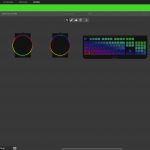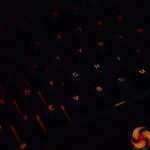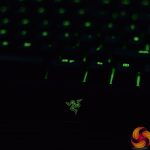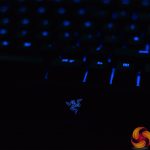To test the BlackWidow, I used it as my daily driver for just over a week – using it for both general typing as well as some gaming.
We break our testing up into four sections: software, lighting, build quality, and performance.
Software
The BlackWidow uses Razer Synapse 3 for the software control. It's a relatively simple implementation for the BlackWidow, with control over two main areas – key layout and profiles, and then the LED lighting.
The first of these areas is the ‘Customize' tab. Here you can re-map pretty much all of the keys to pretty much any function you can think of – be it media controls, a mouse function, or to switch profiles on the keyboard. There's also support for Razer's Hypershift feature, where you can assign a secondary function to any of the keys – which is great to games where you want to use a lot of macros. The Customize page also lets you save up to four profiles directly to the BlackWidow's on-board memory, while you also have effectively unlimited profile storage that is linked to your Razer account in the cloud.
After that, there's the ‘Lighting' tab. At its most basic, you can adjust the LED brightness, configure when the LEDs turn off, and choose from a number of quick effects including ‘fire', ‘ripple' and ‘spectrum cycling'. Things get more interesting when you configure an advanced effect through Chroma Studio – this gives you control over the BlackWidow's LEDs on a per-key basis, and you can stack multiple effects, change the speed and direction of the effects, and decide when the effect starts and stops. It's very in-depth but also quite easy to get the look you are going for.
So on the whole, I have to say Synapse is very easy to use with the BlackWidow. I didn't really have any issues with it – apart from software updates which are still too frequent in my opinion – and it works well, so I have no complaints.
Lighting
Compared to some keyboards we have reviewed recently, the RGB (or Chroma) lighting on the BlackWidow is relatively low-key – there's no LED strips running along the edges of the board, and there's no RGB-enabled wrist rest either. Instead, the lighting just comes from each of the keys, and then the Razer logo on the front edge of the board.
That's not to say the lighting is bad, however – in fact, it is excellent. Each key has its own LED, and the colours really pop – coverage across the keycaps is even, and each LED gets more than bright enough. The LEDs also created a lovely underglow where the light reflects against the white baseplate, too, so the overall effect is just very appealing.
When you factor in all of the custom effects and colour patterns you can create through Chroma Studio, it is my opinion that Razer simply does the best per-key RGB lighting of any keyboard manufacturer. It just looks fantastic.
Build quality
I have to admit, I was pleasantly surprised as to how well-built the BlackWidow feels. Unlike the Huntsman or BlackWidow Elite, its outer-shell is made entirely from plastic – there's no metal top-plate here. That being said, it still feels very sturdy and robust due to the use of an internal metal frame, so there's absolutely minimal flex to the board when I try to pick it up and bend it. My scales have the BlackWidow's weight at 1.2kg, too, so it's not like this is a flimsy board at all.
The one area where I would like to see improvement – something I alluded to on the previous page – is with the keycaps. Razer is not alone here, in my view plenty of other keyboard manufacturers need to up their keycap game, but to me the ABS keycaps used here just feel a bit thin and cheap. They do their job well by allowing the LED lighting to shine through, but they do pick up skin oils and turn glossy very quickly. A set of double-shot PBT included by default would really help set the BlackWidow apart.
Performance
As for the day to day use of the BlackWidow, it is a lovely keyboard for both typing and gaming. This is all due to Razer's own brand of switch used here, in this case the Razer Green. It's broadly similar to a Cherry MX Blue in that it is both tactile and clicky, but it is slightly lighter with an actuation force of 50g, not 60g. It also actuates at 1.9mm, which is 0.1mm lower than a standard Cherry switch.
I personally love both Razer Green switches as well as MX Blues – tactile and clicky is my personal favourite. It is worth saying, however, that Razer is not manufacturing this new BlackWidow with any other switch variety – the company also makes a Yellow switch (linear, similar to MX Speed) and an Orange switch (tactile and non-clicky, similar to MX Brown) but the BlackWidow is only available with Greens.
It's still a good switch for gaming – it may not be the objectively fastest or lightest switch on the market, but I find the tactile feedback helpful when trying to make short, sharp key presses. There's also n-key rollover (verified by using keyboardchecker.com) so you won't have any issues with commands failing to register.
For general typing, however, I don't think you can beat a tactile and clicky switch. The noise will probably annoy most people in the vicinity – this would be one way to make yourself unpopular in the office very quickly – but for me, the tactile bump in tandem with that audible click creates an unrivalled typing experience.
These switches also use Razer's new dual-wall design, which is meant to help increase overall stability of the key and reduce any wobble. I don't have a keyboard to hand that uses the older style of Green switches for a direct comparison, but compared to my Cooler Master MasterKeys Pro S with MX Blues I have to say there isn't really much of a noticeable difference between the two. That's not a bad thing, though – both feel solid and sturdy to type on, I just couldn't say in earnest that I noticed the dual-wall design making a big difference.
 KitGuru KitGuru.net – Tech News | Hardware News | Hardware Reviews | IOS | Mobile | Gaming | Graphics Cards
KitGuru KitGuru.net – Tech News | Hardware News | Hardware Reviews | IOS | Mobile | Gaming | Graphics Cards














